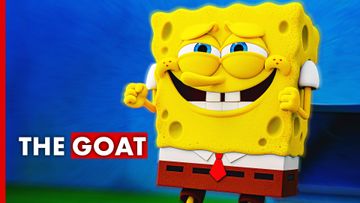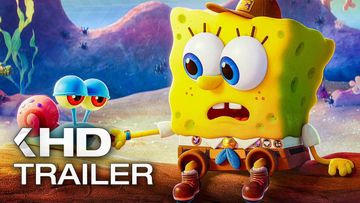The Brilliant Secret to SpongeBob SquarePants' Success
Learn all about the phenomenon of the popular sponge
He's square. He's yellow. And he lives in a pineapple under the sea: SpongeBob SquarePants, the hero of an entire generation. A pop culture phenomenon no one really expected. But how did a squeaky sponge from the ocean become an absolute cult figure? Stay tuned and we will reveal the secret to SpongeBob SquarePants' success!
From the Deep Sea to Pop Culture: The Story of its Origins
The origins of the series are just as peculiar as you would expect from SpongeBob: Stephen Hillenburg, the creator of the cartoon, was originally a marine biologist. He wanted to teach children about underwater life and developed a scientific comic called "The Intertidal Zone". It featured a character who vaguely resembled our beloved sponge. Years later, while working at Nickelodeon, Hillenburg developed this idea into "SpongeBoy" – but the name was already copyrighted. So it became "SpongeBob SquarePants", complete with rolled-up pants and a tie. The rest is history.
Fun fact: Hillenburg deliberately chose a kitchen sponge as a model, even though real sea sponges look completely different. It was easier to animate – and it perfectly matched SpongeBob's personality: clean, tidy, and a little too eager.
Polarizing Characters: SpongeBob and Squidward
SpongeBob was designed as an eternal optimist – almost overly friendly, helpful, and enthusiastic. His character was meant to be annoying, but in the best possible way. To balance things out, Squidward plays the role of a grumpy, artistic octopus who is constantly driven to the brink of insanity by SpongeBob's relentless cheerfulness.
Originally only intended as a minor character, Squidward quickly became a fan favorite. Today, adults in particular tend to identify more with him than with the always good-humored sponge. And here's another little animation fun fact: Squidward only has six tentacles – eight would have been too complex for the animators.
Slapstick, Surrealism, Subculture: The Style of the Series
In the episode "Rock Bottom", for example, SpongeBob gets lost in a dark parallel world with an incomprehensible language and Kafkaesque logic – for many fans, a clever parable about big city bureaucracy and social isolation. And then, of course, there are the legendary urban legends: one of the most famous is the rumor about a never-aired episode involving the so-called Red Mist Squidward: a dark creepypasta with realistic animation and a disturbing atmosphere. Completely made up, but told so persistently that it has long since become part of the myth. Even today, the alleged episode still appears in Reddit threads and YouTube analyses.
SpongeBob Everywhere: Music, Fashion, Movies
SpongeBob was never just a children's series. This is also reflected in the music: be it "F is for Friends", the chaotic "Campfire Song", or "Sweet Victory" – many songs from the series have achieved cult status. The latter, by the way, comes from a music archive and was simply recycled for the iconic Super Bowl parody – resulting in what is now considered one of the best moments in the series. To this day, "Sweet Victory" is regularly used as a meme anthem at sports events and concerts.
SpongeBob's influence doesn't stop at music. The fashion world has long taken notice as well. Brands such as Nike, H&M, and Vans have already launched SpongeBob collections. His face appears on the runways in New York and Paris – ironic, retro, yet at the same time both mainstream and boundary-pushing. On social media, DIY fashion creations featuring SpongeBob prints regularly circulate, too – especially popular among Gen Z and nostalgic millennials.
SpongeBob has also found success at the movies: the very first film, released in 2004, already packed a punch – featuring none other than David Hasselhoff. No joke: a life-sized model of Hasselhoff was built specifically for the film – complete with motorized chest muscles. More movies, spin-offs, and streaming experiments followed – although not always loved by fans, none of it harmed the brand.
Internet, Gaming, Musical: SpongeBob's Reach Knows No Bounds
Some of the more recent projects, such as the prequel "Kamp Koral" or the Netflix movies, divide the community. But at the same time, they show how flexible the franchise has become. With "The SpongeBob Movie: Search for SquarePants" set for Christmas 2025, the fourth theatrical adventure is already in the pipeline. This time, the story revolves around the Flying Dutchman. Series writer Derek Drymon is directing the movie – a name that gives many fans hope for a stylistic throwback to the early days.
SpongeBob has long been an indispensable part of the internet: whether in YouTube remixes, sound effects in Twitch streams, or reaction GIFs on Reddit. Some of the most popular SpongeBob memes have been viewed over a billion times.
The sponge has also established itself as a video game icon: "Battle for Bikini Bottom" from 2003 is now considered a cult classic – including a remake in 2020. There are speedrun tournaments, mods, fan games, and even horror adaptations such as "Sinister Squidward".
Fun fact: SpongeBob even got his own musical. It premiered in 2016 – featuring songs by David Bowie, Cyndi Lauper, and the Plain White T's. It sounds ridiculous, but it became a critics' favorite: the stage show was nominated for numerous Tony Awards and ended up winning for Best Scenic Design.
Between Science, School and Philosophy
SpongeBob has even made his way into science: in 2021, a newly discovered species of sponge was named after him – Spongiforma squarepantsii. Teachers also use SpongeBob in the classroom – for example, to encourage creative thinking or discuss moral issues. There are even philosophical interpretations: Squidward, for instance, has been analyzed as a stoic figure who continues to play his role despite inner dissatisfaction – a symbol of the modern employee. Maybe that's why so many adults can relate to him?
From the Golden Era to Meme Machine
It is also interesting to see how the series has evolved over time. Many fans draw a clear line between the "golden era" of seasons 1 to 3 and the later episodes. While the early episodes were often calm, visually detailed and subtly ironic, later seasons are frequently criticized for being more hectic, garish, and childish. A term often used in fan circles is "Flanderization" – the tendency to reduce characters to a single exaggerated trait. For example, Patrick, the slightly naive but kind-hearted friend, gradually turned into a completely clueless idiot. SpongeBob himself also became more childish and shrill over time, which has not sat well with many long-time fans.
At the same time, it becomes clear how politically charged the perception of SpongeBob can be. In the U.S., there have repeatedly been conservative voices accusing the series of having a "left-liberal agenda" – pointing to things like role distribution, gender-related behavior, or the supposedly subtle critique of capitalism, with Mr. Krabs often mentioned as a prime example.
But SpongeBob was also style-defining from a visual perspective. The unmistakable drawing style – with its "gross-out" close-ups, abrupt changes of style, and occasional live-action inserts – left a lasting mark on the cartoon industry. Series like "Adventure Time" or "The Amazing World of Gumball" build on similar contrasts. SpongeBob was one of the first series to consistently play with media disruption: suddenly zooming into a hyper-realistic, slightly disgusting image – only to return to the colorful cartoon world moments later.
Another often underrated aspect is the sound design. Many of the iconic sounds – from the squeaking of his footsteps to the dramatic zoom sound – come from an old sound library from the 1940s and 1950s. These sounds subconsciously create a feeling of timeless familiarity.
And finally, the vast range of merchandise cannot be overlooked: from toothbrushes and cereals to underwear and popsicles with wonky eyes – SpongeBob is ubiquitous. The licensed products generate billions and go far beyond the original series. By the way: by the end of 2025, the show will comprise a whopping 16 seasons, 332 episodes, and over 600 segments.
Conclusion: A Sponge with Depth
In short: SpongeBob is more than just a series. He is quote, sound, feeling, history, pop, and politics all at once. A cultural chameleon – and perhaps that's exactly why he's so versatile and still relevant today. Whether as a childhood companion, meme machine, or nostalgic comfort food – SpongeBob is here to stay. He has packed friendship, imagination, and self-irony into a shrill, squeaky world that somehow still feels human. Maybe that's the secret: beneath all the nonsense, there is always a kernel of truth.


